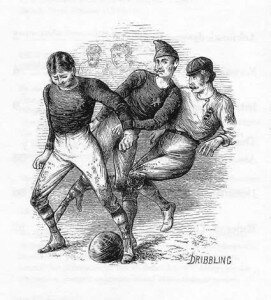Goal Weekly, Monday 11 May 2009, p. 12.
I know this column is called Blast from the Past, but given that most people believe the first game of Association Football was not played in Australia until the 1880s, what, you may ask, am I on about? It is, however, 150 years since the first set of rules for what became Australian Rules were written in Melbourne. The other day when trawling through Bell’s Life in Victoria in 1864 I came across a letter by a fellow who signed himself Free Kick, who was very familiar with what was happening in the United Kingdom and Australia at the time. And this is what he wrote:
‘The game of football appears destined to become as popular in this colony as it has already become in England, where it is now fully recognised as the national winter game. … Within the last year or two … football in England has received a great impetus, and clubs have been formed in various places, the movement having been warmly espoused by many University men, who have to a great extent shaken off their old prejudices, and are favourable to the formation of a universal code of rules, by which, in future, the game should be played. … The Football Association was accordingly formed, and set of rules drawn up, which by a very curious coincidence, are very nearly similar to those which were decided on at a meeting of representatives of football clubs, held at the Parade Hotel, near Melbourne, some 5 years ago. … and it is certainly creditable in every way to the judgment of the gentlemen then appointed, that the very rules they then decided on have subsequently been adopted by the members of the Football Association in England. Whether a stray copy (for the rules were neatly printed and got up) ever found its way home I do not know, but if not it is a strong argument in favour of our own code, that the football parliaments assembled on opposite sides of the globe, should bring the identical same result of their labours.’

Football 1870s style. The Graphic, December 1872, reproduced in The Rules of Association Football 1863, Bodleian Library, Oxford, 2006.
Our man, Free Kick, seems to be suggesting that the clubs which formed the Football Association in 1863 might have gained inspiration for their set of laws of the game from what was happening in Melbourne four years before. To me this is a bit far fetched, and a bit like the claims for Aboriginal or Irish influence on Australian Rules, or at least Melbourne Football Club rules, as drawn up in 1859. But when you read what the Europeans saw Aboriginal children doing you begin to wonder.
Early European settlers and travellers reported the existence of their games and sometimes provided extensive descriptions. Blandowski commented on the game he had seen, which is represented in Mutzel’s etching, ‘The ball is made out of Typha roots: it is not thrown or hit with a bat, but it is kicked in the air with the foot … The aim of the game: never let the ball touch the ground.’
It is beyond doubt that Aboriginal games which used a purposely-made ball existed. Since many of the references apply to the period before 1859, just what did observers have in mind when they used the word ‘football’ to describe what they saw? It could not have been the Australian game since this did not come into existence until then. My good friend, Ian Syson, points out that Blandowski’s description looks more like soccer than Australian rules, or rather the football exercise which we used to perform in our youth in Scotland called ‘keepy-uppy’, keeping the ball off the ground by use of feet and body not arms and hands. Those migrants who came from a Scottish or English background might well have seen and played a similar type of game in their youth, since the majority of reported observations come from people who did not attend English public schools or universities. There was a strong Scottish presence in the western district of Victoria, particularly around Warrnambool and Portland.
One problem with all this, of course, is that there is no real contemporary evidence that the English referred to Australian rules or that the Australians mentioned Aboriginal activities when drawing up their respective codes. So while these are interesting speculations, or myths if you like, it is worthwhile keeping up the search for information on both possibilities. Who knows we may be able to find connections if we look hard enough.







Marnie Haig-Muir: Your review of the latest Rankin is right on the money, Roy. This book...